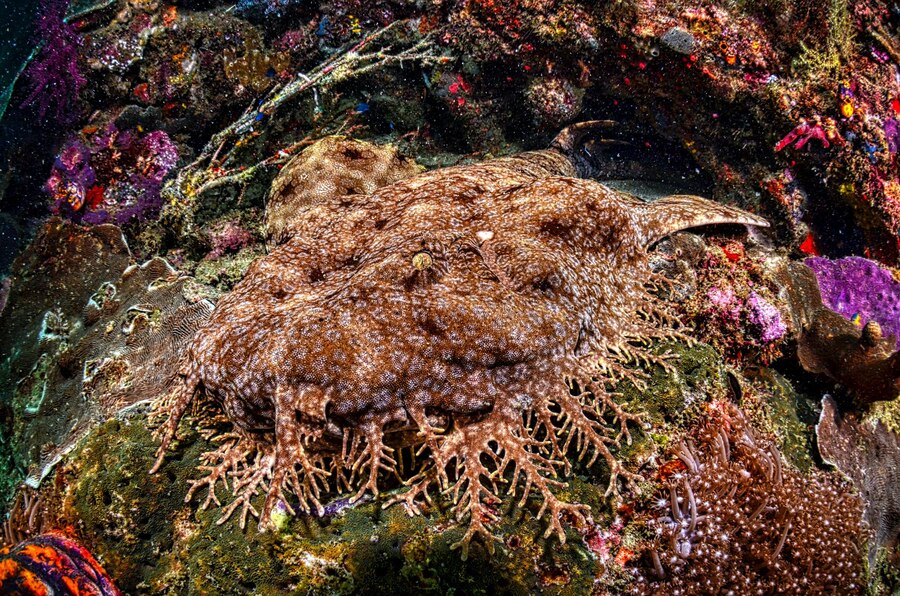THE SEVILLA KNUTSEN [2022] SGHC 20 – DAMAGE TO CORAL REEFS IN THE FEDERATED STATES OF MICRONESIA
February 14, 2022
The SEVILLA KNUTSEN [2022] SGHC 20
PDLEGAL LLC was instructed by P&I Club Assuranceforeningen Skuld to act for the Owners of the vessel Sevilla Knutsen. The Sevilla Knutsen [2022] SGHC 20 appears to be the first reported decision in the Singapore courts involving the assessment of loss arising from damage to coral reefs.
Background:
On 17 April 2017, the Sevilla Knutsen (the “Vessel”), an LNG carrier, struck bottom on the west-facing leeward side of the Eauripik Reef. Her bottom glanced the reef, causing ten distinct scars along the reef crest. She sailed to Singapore for repairs, where she was arrested on the 23rd of June 2017. The Plaintiffs attempted to stay the proceedings in Singapore in favour of a suit to be commenced in the courts of the Federated States of Micronesia (“FSM”), but the Defendant obtained an anti-suit injunction in England to prevent the prosecution or commencement of legal proceedings in respect of the claim in any other jurisdiction other than before the Singapore Courts.
Parties entered into an agreement under O70 r34 of the Rules of Court to settle liability, with the Defendant acknowledging and admitting that it was fully at fault for the damage. However, parties could not agree on damages. This was the crux of the dispute between parties.
Claim for Damages:
The Plaintiffs sought damages for the damage to the reef. In 2017, they obtained a Letter of Undertaking from the Vessel’s P&I Club for the sum of USD 9,247,220.00 (including interests and costs) as security for the Vessel’s release. Parties later negotiated and agreed to a moderation of the security to the sum of USD 5,034,647.00 (including interests and costs) in 2018.
At trial, the Plaintiffs claimed that a total area of 5,478.46m2 had been damaged due to the Vessel glancing off the reef crest and ascribed a multiplier value of USD 1,200 per m2. This placed the Plaintiffs’ claim at USD 6,574,152.00.
The Defendant admitted that it was fully liable for the damage that had been caused but took the position that the Plaintiff’s claims of damage were excessive and unsupported by evidence. The Defendant’s position was that the appropriate area of damage for consideration was 742m2, based on measurements taken by the Defendant’s expert, and the appropriate value multiplier was USD 251.85 per m2, based on precedent case law from the FSM courts.
Given the vast difference in the methods of valuation used by parties in valuing the loss, parties the Plaintiffs brought a claim on reference pursuant to O70 r40 and 41 of the Rules of Court to assess the damages as a result of the casualty. .
The Area of Damage:
There was common ground in the parties’ measurements of the scar area. The Plaintiffs’ expert measured the total area of damage of the scars at 1,178m2, which was later reduced to 1,091m2 using an image-processing software ImageJ. The Defendant’s expert measured an area of damage of 742m2, bounded by length and width rectangles with a total area of 1,022m2.
However, at the commencement of trial, the Plaintiffs expanded the total area of damage to 5,478.46m2 by including the area of damage down the steep reef wall to a depth of 28m and included the undamaged areas between some of the scars.
The Court found that the Plaintiffs should have conducted a follow-up detailed survey with the appropriate equipment so that they could establish with reasonable accuracy and objectivity, the area of damage to the Reef [at [61]]. Unfortunately, the Plaintiffs failed to do so.
Given the lack of evidence proving the Plaintiff’s claim, the Court ultimately found that, save for the Plaintiffs’ expert’s eye-witness account and testimony, there was no objective evidence to prove that there was any damage down to a depth of 28m.
Having determined that the Plaintiffs’ expert had failed to prove the “avalanche effect” which allegedly caused the damage down to a depth of 28m, the Court found that the best available evidence that it could rely on was the evidence where both experts were broadly consistent. [at [75]]
The Court ultimately found that the calculations that came closest to capturing the totality of the damage to the Reef claimed resulted in a total area of damage was 1,056.88m2, the midway point between the Plaintiffs measurement of 1,091m2 and the Defendant’s length and width measurements of 1,022m2.
The Appropriate Multiplier:
There was also common ground in the parties’ approach to determining the appropriate multiplier applicable. Parties agreed that the multiplier precedents gleaned from FSM case law were relevant precedents, and that the starting point was USD 600 per m2. However, parties remained far apart on their assessment of the appropriate multiplier.
The Plaintiffs sought a multiplier of USD1,200 per m2, despite its own expert, Dr Richmond having given evidence in a 2002 FSM case that an appropriate multiplier in that case, was USD 608 per m2. The Court ultimately found that Dr Richmond’s evidence in support of a multiplier of USD 1,200 per m2 was “not based on any scientific formula but is really a qualitative assessment” [at [110]] and that his conclusions were “in essence, “guesstimates’ as opposed to being grounded on any scientific or mathematical basis.” [at [112]].
The Defendant sought a multiplier of USD 251.85 per m2 based on an FSM caselaw precedent for damages to an outer island reef. [1]
The Court agreed with the Defendant that the “more reef less people” principle was a relevant consideration to its decision. The Court also accepted the Defendant’s expert’s point that the Court has a discretion to consider the principle and calibrate the value of the reef accordingly [at [110]].
The Court however disagreed with the Defendant’s reliance on a multiplier of USD 251.85 per m2 determined in the People of Satawal for damage to an outer island reef, finding that it was “not necessarily reflective of the value of the Reef, nor is that a value binding on me” [at [113]] and that unlike the West Fayu island which was more remote and uninhabited, Eauripik was inhabited by about 60 islanders.
Taking notice of valuations in previous cases and settlements, the Court found that the average equivalent value per square metre of the reef damage cases in the Indo-Pacific was approximately USD 461.00 [at [120]].
However, ultimately the Court returned to the Plaintiffs’ alternative argument on the multiplier, that the value of USD 785 per m2 was applicable. This figure was undisputed between parties, being the 2020 value of the USD 600 per m2 value affirmed in the Kyowa Violet after taking into account inflation.
The Court’s Decision:
The Court’s decision ultimately found in favour of the Defendant, finding that the Plaintiffs failed to satisfy its burden of proof[2], and awarded damages of USD 829,650.80, far less than the USD 6,574,152.00 sought by the Plaintiffs.
Key Takeaways:
Despite being an assessment of damages hearing, the decision in The Sevilla Knutsen offers the following takeaways:
Burden of Proof
It is necessary that all available evidence is brought before the Court. As observed by the Court, the Court cannot make its decision based on guesswork. In this case, the Court found on a number of occasions that the Plaintiffs had failed to satisfy their burden of proof by placing before the Court for its determination all relevant evidence proving its claim.
Evidence
It is also necessary, where the evidence is insufficient, that the prosecuting party take steps to place accurate and objective evidence before the Court. In this case, the Court queried the lack of a follow-up survey by the Plaintiffs and found that the argument of allegedly prohibitive costs could not justify the failure by the Plaintiffs to conduct a further survey.
“this is a case which, in my view, cried out for a follow-up detailed survey by the plaintiffs with the appropriate equipment so that they could establish, with reasonable accuracy and objectivity, the area of damage to the Reef. While I note the plaintiffs’ submission that it is difficult and expensive to organise an expedition to the location, costs alone cannot justify a lowering of the legal and evidential burden of proof. In any case, there was no evidence before me that the costs of arranging a further survey (or even a joint survey with the defendant’s expert) would have been prohibitive. If the evidence exists and is obtainable, the court would expect the evidence to be produced – especially where it pertains to evidence of actual physical damage to property. I also bear in mind that the plaintiffs have put forward a sizeable claim in excess of US$6.5m;83 indeed, if the plaintiffs had continued to advance a case based on a hybrid valuation, then as posited by the plaintiffs’ expert Dr Robert H Richmond (“Dr Richmond”) (see [82] below), the claim could have been for as much as US$30m. Somewhat fortuitously, the OPOR Team happened to be on an expedition in the FSM when they were called upon to assist the plaintiffs. The OPOR Team did the best they could with the equipment they had and in the time they had to undertake the survey. However, once the plaintiffs had an idea of the likely substantial quantum of their claim, incurring the cost of undertaking a detailed further survey would have been entirely justifiable and expected of the plaintiffs. There was also no suggestion by the Chiefs that the plaintiffs were unable to afford to undertake such a further survey. I am not aware if, for example, the parties even discussed the possibility of undertaking a joint survey by both sides’ experts, perhaps with the costs being initially shared. Even the OPOR Team’s report mentioned the possibility of using specialised equipment (for example, a Remotely Operated Vessel) on a follow-up trip to properly document the damage on the Reef wall at depths of 28m and below.” At [61].
Expert Witnesses
Despite all the expert witnesses being ably qualified, the Court observed that the Plaintiffs’ experts quantification was “in essence, guesstimates, as opposed to being grounded on any scientific or mathematical basis” – [112]. On this basis, the Court declined to accept the Plaintiff’s valuation of USD 1,200 per m2.
It is trite that the primary duty of expert witnesses is to the Court, which overrides any obligations to the instructing and paying party or parties. Expert evidence is expected to be independent, objective and unbiased. As further observed by the Court, the experts owed a duty to assist the court on matters within their expertise. – [67]
Parties’ choice of expert witnesses plays an important role, and it is key that, when P&I Clubs consider appointing an expert to opine on a technical issue (such as valuation and methods of valuation), that the methodology applied by the expert is properly scrutinised and examined before being placed before the Court.
Choice of Jurisdiction
While forum shopping is to be discouraged, The Sevilla Knutsen demonstrates the Singapore Court’s sound capability in deciding cases, which do not occur within Singapore’s jurisdiction, and which, more pertinently, involve examination of a foreign jurisdiction’s jurisprudence.
The Court’s decision in The Sevilla Knutsen is lengthy and detailed and sets out the Honourable Court’s approach toward scrutinising various methodologies of valuation and valuing property in a different jurisdiction.
[1] The People of Satawal
[2] At [54]. [56] and [61]
Contributed by:
Chambers & Partners – Asia Pacific 2023
PDLegal LLC is pleased to announce that Managing Partner, Peter Doraisamy, has been recognised and ranked by Chambers & Partners (Asia Pacific 2023 for Shipping: Domestic: Litigation). The following quotes appear with Peter’s ranking: –
“Peter Doraisamy of PDLegal in Singapore is a noted shipping lawyer in the market. He handles a wide range of disputes, including ship grounding, cargo and fraud-related cases” – Chambers & Partners – Asia Pacific 2023
“He is excellent in litigation. He has very good control of the case, collecting the right evidence and putting this into a very successful trial.” – Shipping Litigation Client
Chambers and Partners is the leading independent professional legal research company operating across 200 jurisdictions. Chambers and Partners delivers detailed rankings and insights into the world’s leading lawyers and law firms.
This ranking is a testimony to the expertise and experience of the Firm’s shipping practice and would not be possible without the support of our clients and friends.
View All Awards

We’re here to help you.
Whether you're seeking advice, representation, or have general inquiries, we're here to help. if you would like to speak to us for more information, please contact our client services team who will be happy to assist.
Let's Get In Touch
Our Office
- A:
PDLegal LLC Advocates & Solicitors 1 Coleman Street #08-02 The Adelphi Singapore 179803
- E:
- T:
- F:
(65) 6220 0392
- H:
Mon - Fri : 9:00 am - 5:00 pm Sat : 8:30 am - 12:00 pm








